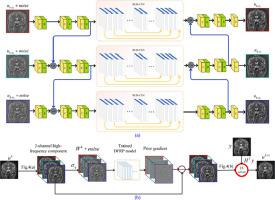Signal Processing ( IF 3.4 ) Pub Date : 2021-09-16 , DOI: 10.1016/j.sigpro.2021.108320 Zhuonan He 1 , Kai Hong 1 , Jinjie Zhou 1 , Dong Liang 2 , Yuhao Wang 1 , Qiegen Liu 1

|
Ill-posed inverse problems in imaging remain an active research topic in several decades, with new approaches constantly emerging. Recognizing that the popular dictionary learning and convolutional sparse coding are both essentially modeling the high-frequency component of an image, which convey most of the semantic information such as texture details, in this work we propose a novel multi-profile high-frequency transform-guided denoising autoencoder for attaining deep frequency-recurrent prior (DFRP). To achieve this goal, we first extract a set of multi-profile high-frequency components via a specific transformation and add artificial Gaussian noise to these high-frequency components as training samples. Then, as the high-frequency prior information is learned, we incorporate it into classical iterative reconstruction by proximal gradient descent. Preliminary results on highly under-sampled magnetic resonance imaging and sparse-view computed tomography reconstruction demonstrated that the proposed method can efficiently reconstruct feature details and presented advantages over state-of-the-arts.
中文翻译:

用于逆成像重建的深度频率循环先验
几十年来,成像中的不适定逆问题仍然是一个活跃的研究课题,新方法不断涌现。认识到流行的字典学习和卷积稀疏编码本质上都是对图像的高频分量进行建模,这些分量传达了大部分语义信息,例如纹理细节,在这项工作中,我们提出了一种新颖的多轮廓高频变换 -用于获得深度频率循环先验(DFRP)的引导去噪自编码器。为了实现这一目标,我们首先通过特定的变换提取一组多轮廓高频分量,并将人工高斯噪声添加到这些高频分量中作为训练样本。然后,随着高频先验信息的学习,我们通过近端梯度下降将其合并到经典迭代重建中。高度欠采样磁共振成像和稀疏视图计算机断层扫描重建的初步结果表明,所提出的方法可以有效地重建特征细节,并具有优于现有技术的优势。











































 京公网安备 11010802027423号
京公网安备 11010802027423号